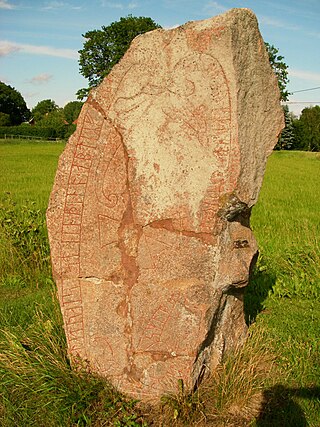Related Research Articles
The Funbo runestones constitute a group of four runestones originally from Funbo in the province of Uppland, Sweden, which were raised by members of the same family during the eleventh century.

The Eggeby stone, designated as U 69 under the Rundata catalog, is a Viking Age memorial runestone that is located at Eggeby, which is 2 kilometers northwest of Central Sundbyberg, Sweden, which was in the historic province of Uppland.

The Jarlabanke Runestones is the name of about 20 runestones written in Old Norse with the Younger Futhark rune script in the 11th century, in Uppland, Sweden.
The Hakon Jarl runestones are Swedish runestones from the time of Canute the Great.
The Ingvar runestones is the name of around 26 Varangian Runestones that were raised in commemoration of those who died in the Swedish Viking expedition to the Caspian Sea of Ingvar the Far-Travelled.

The Orkesta Runestones are a set of 11th-century runestones engraved in Old Norse with the Younger Futhark alphabet that are located at the church of Orkesta, northeast of Stockholm in Sweden.

The Lingsberg Runestones are two 11th-century runestones, listed as U 240 and U 241 in the Rundata catalog, and one fragment, U 242, that are engraved in Old Norse using the younger futhark. They are at the Lingsberg farm about 2 kilometres (1.2 mi) east of Vallentuna, which is about 24 kilometres (15 mi) north of the center of Stockholm, Stockholm County, Sweden, which was part of the former province of Uppland.
The Greece runestones are about 30 runestones containing information related to voyages made by Norsemen to the Byzantine Empire. They were made during the Viking Age until about 1100 and were engraved in the Old Norse language with Scandinavian runes. All the stones have been found in modern-day Sweden, the majority in Uppland and Södermanland. Most were inscribed in memory of members of the Varangian Guard who never returned home, but a few inscriptions mention men who returned with wealth, and a boulder in Ed was engraved on the orders of a former officer of the Guard.

The Tillinge Runestone, designated as U 785 under Rundata, is a Viking Age memorial runestone that was found at the church of Tillinge in Uppland, Sweden.
The England runestones are a group of about 30 runestones in Scandinavia which refer to Viking Age voyages to England. They constitute one of the largest groups of runestones that mention voyages to other countries, and they are comparable in number only to the approximately 30 Greece Runestones and the 26 Ingvar Runestones, of which the latter refer to a Viking expedition to the Caspian Sea region. They were engraved in Old Norse with the Younger Futhark.

The Varangian Runestones are runestones in Scandinavia that mention voyages to the East or the Eastern route, or to more specific eastern locations such as Garðaríki in Eastern Europe.
The Viking runestones are runestones that mention Scandinavians who participated in Viking expeditions. This article treats the runestone that refer to people who took part in voyages abroad, in western Europe, and stones that mention men who were Viking warriors and/or died while travelling in the West. However, it is likely that all of them do not mention men who took part in pillaging. The inscriptions were all engraved in Old Norse with the Younger Futhark. The runestones are unevenly distributed in Scandinavia: Denmark has 250 runestones, Norway has 50 while Iceland has none. Sweden has as many as between 1,700 and 2,500 depending on definition. The Swedish district of Uppland has the highest concentration with as many as 1,196 inscriptions in stone, whereas Södermanland is second with 391.
The Baltic area runestones are Viking runestones in memory of men who took part in peaceful or warlike expeditions across the Baltic Sea, where Finland and the Baltic states are presently located.

The Runestones at Aspa are a set of four runestones located at Aspa, about six kilometers north of Runtuna, Södermanland, Sweden, where a road has passed a creek since prehistoric times. One of the stones, Sö Fv1948;289, is the oldest surviving native Scandinavian source that mentions the Kingdom of Sweden beside the runestones DR 344 and DR 216. Another stone, Sö 137, was apparently raised in memory of a Viking who had spent time in the west.
The Norrtil Runestones are two monuments listed in Rundata as U 410 and U 411, standing at Norrtil, Saint Olovs parish, Uppland, Sweden. Both runestones were erected at the second part of 11th century along the ancient road leading from Sigtuna to already existed at that time settlement of Til.

Uppland Runic Inscription 1145, or U 1145 in the Rundata catalog, is a Viking Age memorial runestone that is located near the town of Tierp in Uppland, Sweden.

Uppland Runic Inscription 130 or U 130 is the Rundata catalog listing for a Viking Age memorial runic inscription which is located at Nora, which is in Danderyd, Stockholm County, Sweden, and in the historic province of Uppland. The runic text directly refers to an estate held in an allodial title.

The Uppland Runic Inscription 258 is a Viking Age runestone engraved in Old Norse with the Younger Futhark runic alphabet. It is in granite and located at Fresta Church in Upplands Väsby Municipality.

The Uppland Runic Inscription 948 is a Viking Age runestone engraved in Old Norse with the Younger Futhark runic alphabet. It is in reddish grey granite and is located at the Fålebro bridge, sunk into the ground, near Danmark Church in Uppsala Municipality. The style is Pr4.

The Uppland Runic Inscription 1028 is a Viking Age runestone engraved in Old Norse with the Younger Futhark runic alphabet. It was found by Johannes Bureus outside the church door of Lena Church and it nowadays visible in the wall inside of the church porch. Lena Church is in Uppsala Municipality.